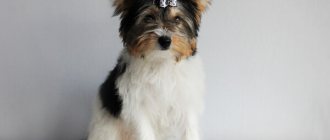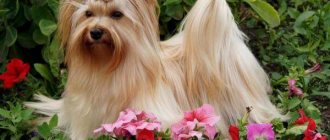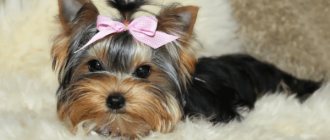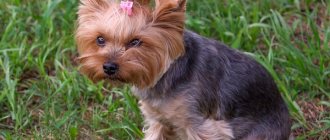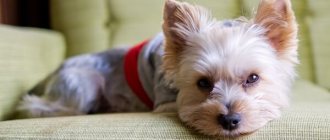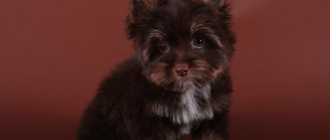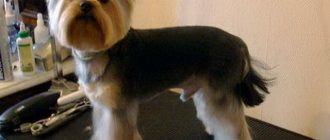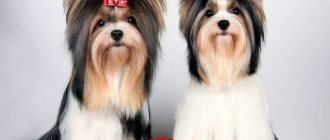In 1984, a pair of ordinary Yorkies gave birth to a puppy with an original color - white spots on the fur . Snowflake, as the baby was named, became the ancestor of the Biewer Yorkshire Terrier breed, named after the kennel owner, Werner Biewer . The Biewer is distinguished from ordinary Yorkies by the inclusion of white spots in its coat, which is why it is sometimes called the White Yorkshire Terrier. This breed was first brought to Russia in 2006, and Biewers immediately charmed lovers of decorative dogs. Now this breed is considered one of the most beautiful in the world.
History of the Biewer Yorkshire Terrier
Descendants of Biewers are Yorkshire Terriers. They have been known as an independent breed since the end of the twentieth century. The reason is the birth of a puppy with an unusual color in a litter of Yorkshire dogs from famous German breeders Gertrud and Werner Biever. A tricolor black, white and gold girl named Snowflake gave birth to a new breed. Further work by dog breeders was aimed at fixing colors at the genotype level. During selection, an unexpectedly appeared recessive gene for black-white-beige coloring became dominant.
In 1988, the Biewer Yorkshire Terrier participated in a dog show for the first time; in 2004, a club for a new breed was opened in Germany, and three years later its standard was approved.
How does a Biewer York differ from a Yorkie?
People who see a Biewer for the first time often ask the question: “How is a Biewer York different from an ordinary Yorkie?” Popular names are “Black and White York” or “White York”. And few people have heard of the existence of such breeds as Goldust and Biro. The fact is that the definition of “York” in Russia has become a generalization for several breeds at once.
Biewer or Biewer York
The breed was bred in Germany more than twenty years ago. Let's not delve into the chronicle and look at the facts. The key characteristic of the breed is color. A combination of white, black, red-red and gold colors. As you can see, the Biewer Terrier is a uniquely colored dog. Biewer puppies sometimes have charcoal markings that turn a steel blue color after three years of age. Previously, there was a rule that white should make up no more than 80% of the Biewer Yorkie's body. Now the situation has changed and the ratio between black and white has become a matter of personal preference, with the only condition being that the colored spots on the dog’s body should not predominate. By the way, the RKF (Russian Kynological Federation) recognized the Breed Standard in 2022, which fixes the name of the breed as “Biewer Terrier” and included them in group 9 (Companions and decorative dogs). Other names: Biewer York, Biewer or Biewer Yorkshire Terrier are still common and common among owners and breeders.
Best Kennels for English Cocker Spaniel breeds
A successful combination of genes provides the Biewer Yorkshire Terrier with good health, improved bone structure and resistance to dislocations. With proper care, the Biewer York practically does not get sick. The weight of York and Beaver is slightly different. The standard sets the desired weight for Biewer in the range from 1.8 to 3.6 kg. While for Yorkies the maximum weight is 3.2 kg. From this it follows that the Beaver is slightly larger than the York.
An undoubted advantage of this breed is the absence of undercoat - the dog practically does not shed. The Biewer Yorkie's coat is more resistant to dirt, although care for light areas is more thorough. It is advisable to have special walking clothes on hand.
Compared to the York, the Biewer Terrier has a slightly calmer character and a balanced psyche. Of course, like any healthy dog, he will demand your attention. Loyal and listen, energetic and smart. Biewer Yorkies are easy to train and are not at all aggressive. An ideal companion in all respects!
You were looking for Beaver, but found Biro?
Biro are the owners of a new and rare “chocolate gene”. The Biro breed is young and appeared in Germany only in 2004, when a puppy of an unusual color was born in a litter of black and white Biewers. A distinctive feature of Biro is the harmonious combination of white, chocolate and gold colors. Currently, the breed is not recognized and is not independent because the basic requirement for the concept of a breed is not met - it is impossible to predict the color of the offspring, even if both parents are biro. However, this does not prevent fans of this dog from creating clubs and holding special breed exhibitions.
Goldust Yorkie or Goldust Yorkshire Terrier
From the literal translation, Goldust means “gold dust.” Representatives of this breed are famous for their white and gold coat color. The breed was bred and registered in Germany. However, it has not received wide recognition in Russia and is more common in Europe. It is noteworthy that the Golddust Yorkie standard allows for a larger weight of dogs - up to five kilograms.
You can find chocolate and black, marbled and golddust Yorkies with blue eyes on sale. Demand for commercial exclusives creates supply. However, when it comes to Biewer Yorkies, you should carefully consider the dog's pedigree/metrics
Pay attention to the origin. The general rule is: two Biewer parents will always produce Biewer puppies
Don't buy a puppy if you feel unsure. Find time and a way to study this issue in more detail. Use information about the parents from the nursery, study the Ingrus pedigree database on the Internet. And after you gain confidence, get a dog and your world will definitely become bigger!
Description of the breed
The first impression of Biewer Yorkshire Terriers is that they are funny mini-dogs, almost toys, which are used as an accessory. This is not entirely true. They have their own character - playful, spontaneous. Dogs are very attached to their owners, get along well with children, and are wary of strangers. The Biewer Terrier is not perceived as a guard; it is very small, but with its ringing bark it will definitely warn of danger.
The appearance of the representatives of the breed is quite interesting - their wool is long, soft, reminiscent of a rich blanket. A distinctive feature is a high ponytail.
The dog is easy to train, can be trained, and can sometimes be stubborn. The established character traits depend on the upbringing and care of the owner for the Mini Yorkie.
York standard
According to the standard, the Biewer Terrier must have the following characteristics:
- Height 21-22 cm, weight 2-3.1 kg.
- The proportional head is round in shape with a flat forehead, the transition to the muzzle is pronounced (at an angle of 90⁰).
- The lips are not droopy, the teeth are small, even, and there is a scissor or pincer bite.
- The eyes are round, wide-set, slightly protruding, with a brown iris and dark eyelids.
- The nose is large, black, upturned.
- The ears are erect, triangular, high, but because of the fur covering them they appear low.
- The body is harmonious, with a straight back.
- The paws are smooth, straight, with developed joints and well-defined muscles.
- The claws are short, thin, white or black.
- The tail is long-haired, high, and cannot be docked.
Dog coat color
The silkiness and softness of the Biewer Yorkshire Terrier's coat cannot be ignored, although it has no undercoat. The color on the head is tricolor - symmetrically located white, black and golden spots are clearly visible. The body is light. Another option is possible - white on a black background.
A characteristic feature of wool is recoloring. By one year, its color lightens, black becomes blue, red becomes beige. The only color that remains unchanged in the Biewer Yorkshire Terrier is white.
Yorkshire Biewer character
Representatives of the breed are distinguished by their ease and friendliness. They are affectionate, sociable, love to play, and are drawn to communication. From terriers they inherited courage, perseverance and, often, stubbornness.
Until old age, Biewer Terriers are open, spontaneous, and at the same time they are unobtrusive and do not cause trouble to others. Many qualities are laid down in the character of Mini Yorkshires even in infancy, in the nursery, if they are socialized and trained.
Despite their small size, dogs cannot become toys for children. They should not be disturbed while eating or sleeping, restrained by force, teased or handled roughly. Children cannot raise a pet; it must have an adult owner, whom the dog respects and obeys unquestioningly.
Description and breed standard
The description of the breed should begin with a brief historical background. It all started in the mid-1980s, when Yorkshire Terrier puppies with white spots were born in the kennel owned by Werner Biewer and his wife. It should be noted that the parents were of the standard color for Yorkies.
It turned out that these dogs are carriers of a rare recessive gene. Nevertheless, Mr. Beaver decided to breed a new breed with this color. Already in 1988, he presented just such dogs to the public in Wiesbaden. But then they were also called black and white Yorkies.
The Biewer Yorkie is a small dog, not tall but quite strong for its height. Characteristic features of the breed are a head with a flat forehead, well-developed, strong jaws. The muzzle may be dark in color; white patches on it are not considered obligatory. The body is wide and muscular, the limbs are strong. White spots must certainly be on the chest, neck and chin.
Several color options are possible - blue (that is, steel gray), black and golden, but white spots are necessarily present in any. The coat of this breed is silky and rarely gets tangled. According to the standard, it should be straight, falling down from the parting on the back.
Above the dog’s forehead, the long hair forms something like a “bang”, which is recommended to be tied with a ribbon so as not to block the pet’s view.
Character
Biewer Yorkies are active and cheerful. The character can be described as friendly and balanced.
These are smart and cheerful dogs, sociable and affectionate. They get along well with all family members, including children. Many Biewer Yorkie owners describe the dogs as intelligent and confident. Pets have inherited many traits from Yorkshire terriers. These are activity, passion, courage and stubbornness. And also - openness and spontaneity, which they retain until old age.
Best Find your cat
But it should be noted that all dogs need to be trained, and Biewer Yorkies are no exception. And the owners will have to show a certain firmness, despite the extremely funny and touching appearance of the puppy.
Similarities and differences between a regular Yorkie and a Biewer
The main difference can be noticed at first glance. Most of the coat is white, which is unacceptable for the British Yorkshire Terrier. Mini Yorkies have a tougher coat that is prone to matting.
There are other differences:
- Biewer Terriers are bolder;
- their psyche is more stable;
- better health, stronger physique;
- They make contact with people more easily and are more obedient.
The similarity of both breeds lies in the presence of beautiful fur, its hypoallergenicity, lack of seasonal shedding, attachment to family members, and sociability.
Character and training
According to the standards of various exhibitions, a pet must be active, energetic, cheerful and confident. He must have a strong-willed and strong character. The dog must have good contact with others. Biewers are considered to be much more even-tempered than the average Yorkie terrier. However, it also depends on how the pet will be raised by its owner.
As for training, Biewers also respond well to it, like other varieties of terriers. The main thing is to be patient, persistent, but show care and love for your pet. You can start training after reaching 3 months. Usually this option is suitable for those who want to show their dog in competitions. For others, a later period is suitable.
During the preparatory stage, it is imperative to pay attention not only to the technical, but also to the psychological nuances of training. It is very important to accustom your baby to a large number of people in one place and begin his socialization. Next you need to familiarize him with the ring. Be sure to not forget about the stand. General commands are also allowed to begin to be practiced from the age of three months. It is recommended to conduct classes not only at home, but also in the fresh air. Be sure to reward your pet with treats during training. The lesson can last no more than 20 minutes.
Although the puppy has a touching appearance, his owner must not change his mind and not be led by his lead, even when his little four-legged friend begins to persist. In general, beavers know very well what is allowed and what is not allowed, so they do not impose their desires. They feel great in apartments. The dog is small, so even a small room will be enough for it, the main thing is to walk it every day and not forget about games.
Features of care and maintenance
Biewer Yorkshire Terriers are groomed regularly. The dog is combed, bathed, trimmed, ears, eyes, claws and teeth are taken care of. Walk twice a day using a leash or harness. The diet consists of natural products or dry food. Meat, fish, vegetables and cereals are cooked until fully cooked. Pelleted food must be of high quality, hypoallergenic, and premium.
Eye and ear care
The German Yorkshire Terrier quite often has severe lacrimation, which is not a disease, but causes discomfort for the pet. Purulent discharge from the eyes not only accumulates in the corners, but leads to darkening of the fur, an unpleasant odor and inflammation. Due to anatomical features, the Biewer Terrier cannot clean its eyes on its own. They are washed daily with cotton pads soaked in a decoction of St. John's wort, chamomile or calendula.
Periodically, the Yorkie's ears are inspected and, if necessary, cleaned with a special lotion and cotton pads. If your dog is bothered by itching in the ear canal, you should contact your veterinarian. To prevent the ears from drooping, they are shaved to a third of the length from the tips.
Grooming
To ensure that the coat remains beautiful and does not mat, the terrier puppy is taught from an early age to be brushed daily using a metal comb and a massage brush. Bathe twice a month using shampoo for white fur and make sure that the dog does not lick it off. First, moisten with warm water, apply a small amount of shampoo, massage in the direction of hair growth and gently rinse. Water should not get into your ears. Next, use the balm, rinse, dry with a towel and hairdryer.
Diet
From two to five months, Yorkshire Biewer puppies are fed at least four times a day, at regular intervals. From seven months to a year, the frequency of feedings is reduced to three times, after a year - to two.
The basis of the diet is boiled lean meat (chicken, beef), liver, and sea fish. As a supplement, give rice or buckwheat porridge boiled until slimy. Pearl barley or oatmeal can cause allergies and are difficult to digest.
Vegetables (except legumes, potatoes and cabbage) are also boiled before feeding, seasoned with vegetable oil or kefir. Sweets, smoked meats, fatty cheese and baked goods should be excluded from the diet.
If dogs are prone to allergies, select high-quality food in the form of small granules.
Clean water at room temperature should be available at all times for any type of diet.
Training and raising a dog
From an early age, the puppy is trained to use the litter box, but walking is essential. Some time after feeding, he begins to sniff and behaves restlessly. At this moment, the puppy is taken for a walk. It is necessary to gradually accustom him to a leash and collar or harness. First they put it on for a few minutes, then distract it with a treat, increasing the time.
For the safety of the dog and the peace of mind of the owner, it is taught the commands “No”, “Fu”, “Come to me”, “Sit”, “Place”, “Lie down”.
Hygiene procedures, haircut
Grooming a dog includes a whole range of hygiene procedures that the owner can perform independently. Starting from two to three months, the pet can gradually be accustomed to cleaning tartar from teeth, ears, eye treatment and pedicure.
Grooming long hair is quite tedious, so many owners prefer to give their terrier a stylish haircut that will highlight its beauty and individual characteristics. First, the dog's fur is combed out, washed and dried well, stretched so that it does not curl. The first time puppies get a hygienic haircut is when they are two months old - their paws, ears, belly are cut, and the hair on their head is straightened. Once every four months, adult Yorkshire terriers receive a model haircut, their hairs are trimmed, and their ears are shaved by a third.
Mating mini Yorkshire terrier Biewer
Healthy dogs with excellent conformation and pedigree that fully comply with the standard are suitable for breeding. Males are ready for mating at one year of age, but they are allowed to breed at one and a half to two years of age. The coverage rate is no more than 20 bitches per year. The breeding animal is provided with good nutrition, rich in protein, and regular walks. They are used for mating until they reach eight to ten years of age; at a more mature age, the quality of the sires decreases.
The first mating of bitches is carried out at one and a half to two years. If pregnancy has not occurred before the age of four, it is better not to do this again, so as not to increase the risk of a dangerous late birth. A female is allowed to have no more than six litters. Knitting after eight years is not recommended.
Diseases and vaccinations
Decorative dogs are susceptible to a number of diseases, which can be avoided by studying breed lines, observation by a veterinarian, and properly organized maintenance and care. The Biewer Yorkshire Terrier may have the following pathologies:
- lameness;
- cardiomyopathy;
- pancreatitis;
- muscle atrophy;
- tracheal collapse.
To combat infections, vaccinations are necessary, which begin at two months, after giving the puppies anthelmintic. The next vaccination is carried out after changing teeth (at ten months). A mandatory condition is compliance with quarantine for two weeks. You should consult your veterinarian about the schedule of further vaccinations.
Caring for a puppy and an adult
In order to know how to care for a Labrador puppy and an adult, it is important to understand that care is not limited only to hygiene or feeding, complete care has multiple components. To maintain your dog, do the following regularly:
Bathing
Wash your Labrador only when necessary and when dirty. It is forbidden to use human shampoos, only dog products. The water should not be cold or hot.
After swimming in open water, rinse with running water and dry. In winter, refrain from water treatments. Avoid blow-drying; simply wipe with a dry towel.
Washing paws after walks is mandatory. In the summer, removing dust and dirt from the fur with a damp cloth after each walk, there is no need to bathe it completely.
Wool
Brush your pet weekly, the brush should not be hard, the length of the teeth should be medium.
During the molting period, scratch every day, thoroughly, for 20 - 30 minutes, paying special attention to: the abdomen, groin area
During the molting period, the fur and undercoat are removed with a slicker brush, the dog is washed more often, which promotes skin renewal.
Eyes and ears
The eyes are wiped 2-3 times a week with a decoction of herbs with an antiseptic effect (chamomile) or a weak solution of tea leaves, a specialized care lotion.
Clean your ears as they become dirty or at least 2 times a month. A cotton pad or swab soaked in lotion or dry. There is no need to press hard in the ear. Monitor the nature of the discharge: is there any redness or a strong odor.
Teeth
They can be cleaned independently using a brush. Or dental veterinary remedies are given in the form of “bones”, which help cleanse, remove plaque from the teeth and improve digestion.
Give solid food to chew: large moles, raw carrots, apples.
Claws
With sufficient physical activity and constant running, they wear off on their own. You can remove it yourself using a nail clipper.
It is important to do the procedure carefully, trying not to injure the body of the claw. Teach from an early age, after each haircut - give a treat and praise
Vaccination regimen and treatment against parasites
The first vaccinations are given by the breeder; you just need to follow the schedule and get vaccinated on time. Puppies have their own schedule, adults are vaccinated according to a different schedule.
Visit the veterinarian for a simple check-up once every six months. Mandatory consultations before changing food or mating, choosing food additives and vitamin complexes, only with the recommendation of a veterinarian. pharmacy or veterinarian.
Treatment for parasites, strictly according to the season. Before the start of the spring-summer period, processing the wool and wearing a collar. Check your fur and skin regularly for ticks, especially after traveling outside the city.
Exercise stress
Walk at least 2 times a day - for an adult; take a puppy out 3-4 times for short periods of time.
Provide exercise for adults - free running, joint jogging with the owner. Free games with a ball, frisbee, games with other animals.
The duration of the baby's walks is gradually increased; it is important to ensure that he does not pick up food from the ground or dig through the trash. Let go of the leash and waste only when you know the basics of the command or you are sure that there is no danger nearby
You can take a Labrador on mini trips, ride a bike or ski together. Walks together should be long, fun and productive for both pet and person.
Advantages and disadvantages of the Biewer York Terrier
Terriers easily find contact with all family members because they have a number of advantages:
- good disposition;
- agreeableness;
- livability;
- energy, playfulness;
- small in size;
- attractive appearance;
- hypoallergenic;
- learning ability.
Disadvantages of the breed:
- stubbornness;
- the need for constant coat care;
- sensitivity to hypothermia;
- presence of specific diseases;
- high cost of puppies.
How to care for your pet
The puppy should be taught proper care and hygiene procedures from a very early age. Comprehensive pet care includes coat care, water treatments, oral care, claws, ears and eyes.
Also, to successfully keep a dog, you need to know about some of the nuances of walking. Next, we will analyze each point in more detail.
Grooming and bathing
Your pet's long, shiny, silky coat requires careful care to remain as attractive. To maintain the beauty and health of their coat, dogs need regular, daily combing and trimming (1-2 times a month).
When preparing for exhibitions, you should choose from standard haircuts, but if the dog is not preparing for a competition, you can give free rein to your imagination and experiment. In the summer, the dog may be overheated, so it is better to prefer a short, neat haircut.
Important! It is worth considering that some dogs have a wool that is not silky, but has a more “cotton” structure. This type of fur is extremely difficult to grow; it quickly becomes matted and forms tangles.
Best Jack Russell Terrier Puppies
In this case, it is more rational to do a haircut - this will save you and the dog hours spent on combing, as well as nerves.
You should also hygienically trim the ears and muzzle. This procedure is especially important during the formation of ears.
If your dog's diet contains natural or wet food, the chin should be cleaned after each feeding.
Bathing should be done every week or two. If you carry out water procedures more often, the animal's skin may dry out due to the lack of undercoat.
For bathing and combing you need to purchase the following tools and products:
- comb with sparse teeth;
- shampoo;
- air conditioner;
- antistatic (detangler);
- ear sponges to prevent water from getting in.
Then you can start swimming. When lathering, try not to tangle the hair.
After rinsing the shampoo, apply conditioner for a few minutes and rinse the coat thoroughly again. When drying with a hairdryer, the wool can be combed out at the same time.
If you follow these procedures, your pet's hair will always be in perfect shape. However, remember that a balanced diet plays an important role in the beauty and health of the coat, which we will talk about below.
Eyes, ears, teeth, claws: necessary procedures
Other hygiene procedures include care for the eyes and ears, mouth and paws:
- Discharge from the eyes should be removed daily with a soft cotton pad. Remember that some dogs have more severe tearing, this is not a problem and requires more frequent eye rubbing. If you do not take proper care of your eyes, you may develop infection, irritation, and spots.
- You can also use cotton pads to clean your ears. Do not try to clean the natural folds of the ears from secretions. To facilitate hygiene procedures and reduce weight, ear hair should be regularly trimmed to 1/3 of the length of the ear, starting from the tip. For cleansing, you can use special powders and lotions.
- Nails should be trimmed once a month. Try to cut parallel to the natural cut line, without going beyond the areas where the nerve endings and blood vessels are located.
- The paw pads also need to be periodically cleaned of debris and tangled hair trimmed from the paws.
- When caring for your dog's oral cavity, you can use special pastes and sprays, toothbrushes and cleaning toys. Twice a year you need to undergo a thorough cleaning at the veterinary clinic. Such procedures will not only eliminate unpleasant odor, caries and plaque, but will also allow you to preserve the dog’s healthy natural teeth for a long time.
Walk
Before starting walks, the puppy must be accustomed to a collar and leash. It is better to do this in the apartment during the game. For your first walks, it is better to choose the quietest time of the day, when there are no cars driving yet.
The duration of the first walks should be about 10 minutes - even such a short time can be stressful for the puppy, full of a lot of new impressions and emotions.
Bievers generally respond well to children and other dogs. However, do not allow strangers to get too close to your pet, much less feed it. To avoid unexpected and dangerous situations, Biewer Yorkies should always be walked on a leash.
Important! For autumn-spring and winter, you need to purchase appropriate clothing and shoes. Hypothermia is dangerous for Biewer Yorkies, especially for very small dogs.
Who is better to choose - Biewer or Yorkie?
Since the mini breed was developed from regular Yorkshire Terriers, they have a lot in common. When choosing a puppy, you should focus on which of the characteristics suits and pleases the dog breeder more. The Biewer Terrier has a light coat that is resistant to dirt and is less likely to get sick. The Yorkie is slightly larger, but needs to be insulated with special clothing in cold, rainy and windy weather.
The best way out is to personally visit the kennel and choose a puppy not from a photograph, but in person, observing its behavior and character.
Beaver health status
Biewers are a long-lived breed; the first representatives of the breed lived up to fifteen to seventeen years, so a long life can be predicted for a pet of this breed. Small dogs are characterized by fairly good health, but can suffer from genetically determined pathologies that are inherited.
Biewer Yorkies can suffer from gum and dental diseases, pancreatitis, and tracheal collapse.
Beavers are often diagnosed with:
- Diseases of the gums and teeth (inflammation, gingivitis, etc.).
- Irritation of the mucous membranes of the eyes.
- Legg-Peters disease. Symptoms: muscle atrophy and lameness.
- Tracheal collapse. It occurs predominantly in short dogs and is characterized by suffocation and loss of consciousness.
- Heart diseases. Any cardiomyopathies cause weakness, shortness of breath, fatigue and stunted growth.
- Acute pancreatitis. Symptoms – vomiting, diarrhea, fever, most often provoked by overeating.
Suitable nicknames for Biewer Yorkies
The same beautiful nicknames are suitable for the gentle and spectacular representatives of the Biewer Yorkshire Terrier breed. Boys can be called:
- Amur.
- Bailey.
- Volt.
- Grayson.
- Henry.
- Jake.
- Dylan.
- Connor.
- Lotus.
- Leo.
- Mason.
- Morgan.
- Neo.
- Aries.
- Richie.
- Sammy.
- Topaz.
- Hugh.
- Charlie and others.
For girls, the top names are:
- Asya.
- Ava.
- Abi.
- Bailey.
- Viola.
- Bella.
- Gracie.
- Izzy.
- Clara.
- Lottie.
- Lola.
- Liv.
- Mia.
- Paisley.
- Puma.
- Riley.
- Sophie.
- Flory.
- Chloe.
- Hannah.
- Ella.
Positive aspects of the breed
- Appearance . The Biewer Yorkshire Terrier is very beautiful. Long, flowing, silky fur, beady eyes, a doll-like face - this is one of those breeds that you cannot pass by without paying attention. In addition, the structure and length of the coat allows you to create all kinds of hairstyles and haircuts that will give your pet individuality.
- Hypoallergenic . The structure of the Biewer Yorkie's coat is close to human hair, so the dog is ideal for those who are allergic to dog hair.
- Cheerful disposition . This is a real fluffy energizer, ready to play from morning to night. The beaver will support its owner in any fun endeavor: from a walk at any time of the day to playing with a cat's bow on a string.
- Stable psyche . With proper care, care and education, the Biewer has amazing adequacy and balance. He won’t just bark at pigeons on a walk or throw himself from under the sofa onto his owner’s heel. Therefore, Biewer Yorkies can often be seen on red carpets, in restaurants and at social events. And an ordinary family can safely go with their pet on a visit or on vacation.
- Good contact with small children . Often families with small children who dream of having a dog are unable to make a choice for a long time. Because they need a breed that is safe for the child, moderately playful and does not cause unnecessary trouble with walking. Beaver is the perfect combination of all these qualities. He is a wonderful children's companion, capable of supporting his little owner in all games.
- High level of empathy . Beavers sense the mood and internal state of their owners very well. They will not bother you if they feel that their owners have no time for them, or pester sick children. These are sensitive dogs that will be able to provide true psychological support to their family.
- Regular walks are optional . Small size and good learning abilities will make it easy to accustom a small Biewer to the indoor toilet. Of course, walking with a dog is necessary in any case, but the skills of walking in a diaper or in a litter box will make life much easier for the owners.
How much does a Biewer Yorkie puppy cost?
You can only buy a terrier from a well-known kennel. It is there that the future owner will be provided with all the documents for him. Before purchasing a dog, you need to choose the class and gender of the Yorkshire. If you want to participate in shows in the future, you need a show or breed class puppy with excellent pedigree and standards. This one costs from 50,000 to 60,000 rubles. If you are buying a Yorkie “for yourself” and are willing to put up with some violations of the standard, choose a pet-class puppy or buy from private breeders. Its price is from 15,000 to 20,000 rubles. The main thing is that the pet is healthy and active.
Health
The average lifespan of a Biewer Yorkshire Terrier is about 13-15 years, although with proper care and nutrition such a dog can live much longer (17-18 years). A dog with good health is, unfortunately, not about a Biewer. Although, when compared with the Yorkshire Terrier, the Biewer York has stronger immunity.
You can avoid many health problems if you get vaccinated on time, treat for external and internal parasites, and visit the veterinary clinic with your dog every year for preventive examinations, tests and x-rays.
It is important to know that a healthy animal behaves actively, has shiny fur, shining eyes, and an excellent appetite. If your pet is lethargic, inactive, the fur has become dull and falls into clumps, or has lost its appetite, then it’s time to sound the alarm and immediately contact a veterinarian. It is much easier to fight a disease at an early stage of its development. Biewer Yorkies have a predisposition to the following health problems:
- Legg-Perthes disease is death of the head of the femur, accompanied by lameness. Leads to muscle atrophy. It can only be eliminated surgically.
- Portacaval shunt is a hereditary disease of the vascular system. It is treated with surgery.
- Tracheal collapse is a progressive dorsoventral flattening of the tracheal lumen. Treated with medication.
- Pancreatitis - if left untreated, the pancreas is destroyed, eventually the animal dies.
- Reacts poorly to anesthesia.
- Frequent dental problems. If your Yorkie has not received permanent teeth instead of baby teeth by 7 months, contact your veterinarian. Yorkies also often experience early tooth decay, tartar, and increased sensitivity of the gums.
Reviews from Biewer Yorkshire Terrier owners
Diana, Rostov-on-Don:
We brought the Biewer Terrier boy home when he was already two months old. He is vaccinated and trained to wear a diaper, so there are no particular problems with the toilet, although he often marks everything around him. We only walk outside on our hands or on a leash, because it’s very easy to get lost. As soon as the Yorkie sees a person walking, he runs after his feet. He is cheerful in nature and doesn’t let up all day long.
Alexandra, Moscow:
I was given a Biewer Yorkshire Terrier named Sam for my birthday two years ago. After this, I no longer have free time - I need to communicate with him, play, walk him. He goes to the toilet both outside and in the litter tray. He gets very bored if I leave, worries, lies in his place and doesn’t get up until I show up. Then joy knows no bounds. The love and devotion in him is simply immeasurable.
Nutrition for an adult Labrador and a puppy
There are two types of food for dogs: natural feeding and commercial feeding. The owner decides which one to choose; upon arrival at the house, the puppies eat the food they were kept on by the breeder. Transition to a new type of food
Caring for a small Labrador puppy involves feeding 5 – 6 times a day with a time interval of 4 hours. Portions are small, intended for 1 serving. Transfer to 3-4 meals a day from 5-6 months, after six months 4 times, from the age of 12 months 2 meals a day. Adults eat 2 times a day after a walk, provide access to fresh, drinking water.
Dry food
Selected based on physical activity, age and characteristics of the Labrador. The feed is already fully balanced and does not require additional supplements in the form of vitamins and minerals. For puppies up to 4 months, soak in warm water until completely swollen and homogeneous.
Preference is given to premium and super-premium food. Easy to store, no preparation required, fully balanced and meets all necessary requirements.
A bag of 3 - 5 kg is enough for 2 - 3 months. Labradors are prone to weight gain; improperly selected food can cause digestive problems.
Natural nutrition
For natural nutrition use the following products:
- Meat of low fat content, without bones and veins (veal, beef, turkey and chicken);
- Dairy products (cottage cheese, kefir and cheese);
- Eggs;
- Porridge (buckwheat, rice, wheat, oatmeal);
- Vegetables: zucchini, pumpkin, carrots, tomatoes, cucumbers, cabbage;
- Greens and lettuce;
- By-products: brain, stomach, lung, liver, heart;
- Sea fish;
- Fruits: apples, apricots, peaches, pear and banana;
- Bone flour;
- Vegetable fats;
- Additionally: large cartilages - gnaw;
Exclude from the diet:
- Bones, fish, chicken, any tubular;
- Grapes, plum;
- Pasta, bread;
- Spices;
- Potato;
- Citrus;
- River fish;
- Fat meat;
- Chocolate and sweets;
- Legumes.
Reproduction and lifespan
Good care, proper diet and feeding allow Biewers to live 12-15 years, sometimes more. If the owners of a couple of mature dogs dream of having offspring from them, then they need to take care of the prevention of infections and hormonal abnormalities.
Pregnancy lasts 58-65 days. The female needs more calcium for the development of her offspring, so the food needs to be enriched and slightly increased in volume. Walking should be maintained to maintain muscle tone. The mother's coat is shortened slightly for ease of grooming. In a litter, as a rule, there are 4-6 puppies, although there are exceptional cases of up to 10 heirs.
Up to 25 days, the babies are inseparably with their mother, who feeds the puppies with milk. Then they gradually begin feeding, with which the first steps of independent life begin.
Biewer diseases
Decorative breeds have their own characteristics. Biewer Yorkies are no exception. Features of babies are the diseases to which these dogs are susceptible. Hereditary and acquired diseases occur in little companions:
- Extrahepatic portacaval (portosystemic) shunts are an incorrect connection of parts of the portal vein when the branches of the vein bypass the liver. Because of this vascular pathology, the dog does not develop and suffers from constant convulsions and vomiting. If surgery is not performed, death is possible.
- Pancreatitis in acute form. Biewers have a delicate digestive system. Due to an unbalanced diet or overfeeding, pancreatic disease may occur.
- Other misfortunes are also associated with an incorrectly composed diet: the formation of tartar and gum disease.
- Fractures or dislocations of limbs often occur when the dog is not handled carefully. Little fidgets are extremely active. If they jump from furniture unsuccessfully, they can easily break their paw.
- Long bangs that fall over the eyes can cause your dog to have vision problems. It is recommended to pin your bangs. Moreover, a ponytail gathered and secured with a beautiful hairpin on the pet’s head looks cute and playful.
Biewer Yorkies are recommended to have their bangs pinned up.
To avoid any health problems for your four-legged friend, it is recommended to closely monitor him and regularly visit the veterinarian
